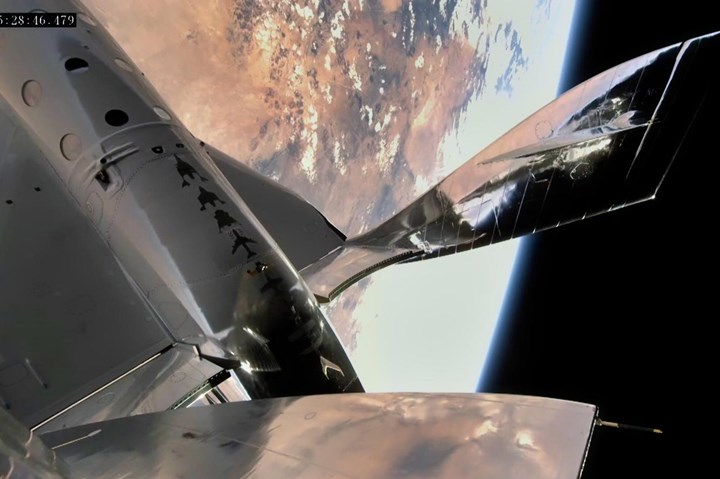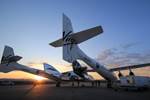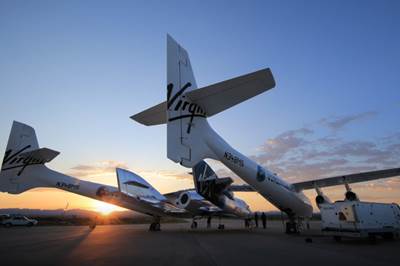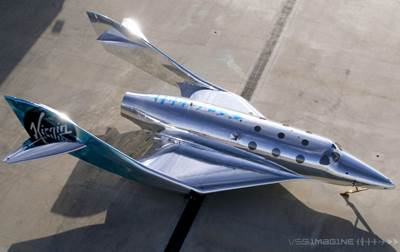Virgin Galactic SpaceShipTwo completes third crewed spaceflight
All-composite VSS Unity reached suborbital space at a speed of Mach 3, marking the first human spaceflight from its New Mexico home port, and another step toward commercial operations.

VSS Unity hovering over New Mexico in space. Photo Credit: Virgin Galactic
On May 22 Virgin Galactic (Mojave, Calif., U.S.) completed its third spaceflight (the second occured back in February 2019) and the all-composite VSS Unity’s first spaceflight from Spaceport America (Las Cruces, N.M., U.S.). This flight, reports the company, sees New Mexico become the third U.S. state to launch humans into space.
The SpaceShipTwo vehicle achieved a speed of Mach 3 after being released from the mothership, VMS Eve, and reached space, at an altitude of 55.45 miles before gliding smoothly to a runway landing at Spaceport America.
On VSS Unity’s flight deck were CJ Sturckow and Dave Mackay, while Kelly Latimer and Michael Masucci piloted VMS Eve. CJ, who flew as pilot-in-command, is said to have become the first person to have flown to space from three different states. Virgin Galactic notes that the crew experienced extraordinary views of the bright, blue-rimmed curvature of the earth against the blackness of space. New Mexico’s White Sands National Park sparkled brilliantly below. Their experience gives Virgin Galactic’s Future Astronaut customers a glimpse of what lies ahead.
“This flight showcased the inherent elegance and safety of our spaceflight system, while marking a major step forward for both Virgin Galactic and human spaceflight in New Mexico,” says Michael Colglazier, CEO of Virgin Galactic. “Space travel is a bold and adventurous endeavor, and I am proud of our talented team for making the dream of private space travel a reality. We will immediately begin processing the data gained from this successful test flight, and we look forward to sharing news on our next planned milestone.”
Virgin Galactic fulfilled a number of test objectives during the flight, including:
- Carried revenue-generating scientific research experiments as part of NASA’s Flight Opportunities Program.
- Collected data to be used for the final two verification reports that are required as part of the current Federal Aviation Administration (FAA) commercial reusable spacecraft operator’s license.
- Tested the spaceship’s upgraded horizontal stabilizers and flight controls and validated EMI reductions.
Following the flight, and in line with normal procedures, Virgin Galactic says it will conduct a review of all test data gathered and thoroughly inspect the spaceship and mothership. Once the team confirms the results, the company plans to proceed to the next flight test milestone.
To celebrate the first human spaceflight from New Mexico, the Zia Sun Symbol of New Mexico’s state flag was placed prominently on the exterior of the Spaceship. In addition, the company flew green chile seeds, synonymous with the state’s rich agricultural and culinary history.
“Fifteen years ago, New Mexico embarked on a journey to create the world’s first commercial spaceport,’’ says Sir Richard Branson. “Today [May 22], we launched the first human spaceflight from that very same place, marking an important milestone for both Virgin Galactic and New Mexico. I am proud of the team for their hard work and grateful to the people of New Mexico who have been unwavering in their commitment for commercial spaceflight from day one. Their belief and support have made this historic achievement possible.”
This spaceflight was conducted under strict COVID-19 protocols.
Related Content
Combining multifunctional thermoplastic composites, additive manufacturing for next-gen airframe structures
The DOMMINIO project combines AFP with 3D printed gyroid cores, embedded SHM sensors and smart materials for induction-driven disassembly of parts at end of life.
Read MorePEEK vs. PEKK vs. PAEK and continuous compression molding
Suppliers of thermoplastics and carbon fiber chime in regarding PEEK vs. PEKK, and now PAEK, as well as in-situ consolidation — the supply chain for thermoplastic tape composites continues to evolve.
Read MorePlant tour: Middle River Aerostructure Systems, Baltimore, Md., U.S.
The historic Martin Aircraft factory is advancing digitized automation for more sustainable production of composite aerostructures.
Read MoreThe potential for thermoplastic composite nacelles
Collins Aerospace draws on global team, decades of experience to demonstrate large, curved AFP and welded structures for the next generation of aircraft.
Read MoreRead Next
SpaceShip Two prepares for first spaceflight
Virgin Galactic prepares its vehicles, pilots, team and facilities with rigorous pre-flight checks and objectives before the flight which will be carried out later this fall.
Read MoreVirgin Galactic SpaceShip III unveiling to deliver commercial space travel
Manufacturing ramp-up and ground testing for VSS Imagine spaceship within the Virgin Galactic fleet, with glide flights commenced for summer 2021.
Read MoreVIDEO: High-volume processing for fiberglass components
Cannon Ergos, a company specializing in high-ton presses and equipment for composites fabrication and plastics processing, displayed automotive and industrial components at CAMX 2024.
Read More

























